The Book of Kings is a book in the Hebrew Bible, found as two books in the Old Testament of the Christian Bible. It concludes the Deuteronomistic history, a history of ancient Israel also including the books of Joshua, Judges, and Samuel.

Elijah was a prophet and miracle worker who lived in the northern kingdom of Israel during the reign of King Ahab, according to the Books of Kings in the Hebrew Bible.

The Order of the Brothers of the Blessed Virgin Mary of Mount Carmel, known as the Carmelites or sometimes by synecdoche known simply as Carmel, is a mendicant order in the Catholic Church for both men and women. Historical records about its origin remain uncertain; it was probably founded in the 12th century on Mount Carmel in what is now Israel.

Haifa is the third-largest city in Israel—after Jerusalem and Tel Aviv—with a population of 290,306 in 2022. The city of Haifa forms part of the Haifa metropolitan area, the third-most populous metropolitan area in Israel. It is home to the Baháʼí Faith's Baháʼí World Centre, and is a UNESCO World Heritage Site and a destination for Baháʼí pilgrimage.

A patron saint, patroness saint, patron hallow or heavenly protector is a saint who in Catholicism, Lutheranism, Anglicanism, Eastern Orthodoxy or Oriental Orthodoxy is regarded as the heavenly advocate of a nation, place, craft, activity, class, clan, family, or person.

Mount Carmel, also known in Arabic as Mount Mar Elias, is a coastal mountain range in northern Israel stretching from the Mediterranean Sea towards the southeast. The range is a UNESCO biosphere reserve. A number of towns are situated there, most notably Haifa, Israel's third largest city, located on the northern and western slopes.

The Well of Souls, is a partly natural, partly man-made cave located inside the Foundation Stone under the Dome of the Rock shrine on the Temple Mount in Jerusalem. During the Crusader period, it was known to Christians as the "Holy of Holies", referring to the inner sanctum of the former Jewish Temple, which, according to modern scholarship, was probably located on top of the Foundation Stone.

The National Maritime Museum is a maritime and archaeological museum in Haifa, Israel.

Jezebel was the daughter of Ithobaal I of Tyre and the wife of Ahab, King of Israel, according to the Book of Kings of the Hebrew Bible.
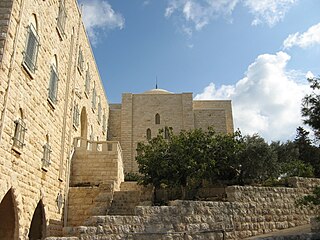
French Carmel is a neighbourhood of Haifa in Israel, located on the western slopes of Mount Carmel. The population is predominantly Jewish.

The Baháʼí World Centre buildings are buildings that are part of the Baháʼí World Centre in Israel. The Baháʼí World Centre buildings include both the Baháʼí holy places used for pilgrimage and the international administrative bodies of the Baháʼí Faith; they comprise more than 20 different administrative offices, pilgrim buildings, libraries, archives, historical residences, and shrines. These structures are all set amidst more than 30 different gardens or individual terraces.
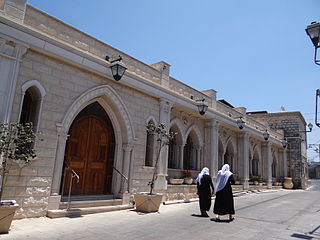
Daliyat al-Karmel is a Druze town located on Mount Carmel in the Haifa District of Israel, around 20 km southeast of Haifa. In 2022 its population was 18,001.
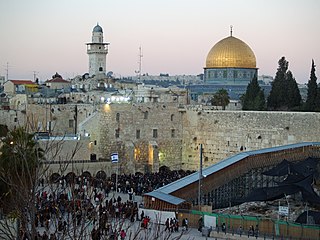
Tourism in Israel is a major economic sector and a significant source of national income. Israel offers a plethora of historical and religious sites, beach resorts, natural sites, archaeological tourism, heritage tourism, adventure tourism, and ecotourism. For practical reasons, this article also covers tourism in the West Bank and the Golan Heights, since it is closely interconnected with the mass tourism in Israel. In 2019, Israel saw a record 4.55 million tourist arrivals, with tourism contributing NIS 20 billion to the national economy in 2017.

The Discalced Carmelites, known officially as the Order of the Discalced Brothers of the Blessed Virgin Mary of Mount Carmel or the Order of Discalced Carmelites, is a Catholic mendicant order with roots in the eremitic tradition of the Desert Fathers. The order was established in the 16th century, pursuant to the reform of the Carmelite Order by two Spanish saints, Teresa of Ávila (foundress) and John of the Cross (co-founder). Discalced is derived from Latin, meaning "without shoes".

The history of Haifa dates back before the 3rd century BCE. Since then it has been controlled by several civilizations, including the Canaanites, Israelites, Persians, Romans, Byzantines, Muslims, Crusaders, Kurds, the Mamluks, the Ottoman Turks and the British; currently it is a major city in Israel.

The Stella Maris Monastery is a Catholic Christian monastery for Discalced Carmelite monks, located on the slopes of Mount Carmel in Haifa, Israel.

Nabi Shuʿayb, known in English as Jethro's tomb, is a religious shrine west of Tiberias, in the Lower Galilee region of Israel, containing the purported tomb of prophet Shuayb, identified with the biblical Jethro, Moses' father-in-law. The complex hosting the tomb is the most important religious site in the Druze religion. A Druze religious festival takes place in the shrine every year in April.
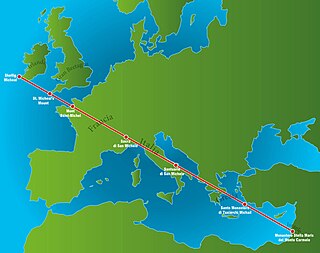
The Saint Michael's Line, also known as the Sword of Saint Michael, is a postulated ley line connecting seven monasteries and in Europe and the Holy Land, six of which are dedicated to the Archangel Michael.
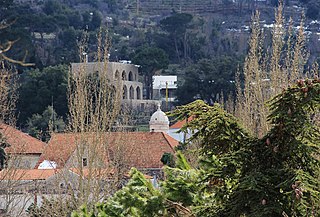
Christianity and Druze are Abrahamic religions that share a historical traditional connection with some major theological differences. The two faiths share a common place of origin in the Middle East and are both monotheistic. Christian and Druze communities share a long history of interaction dating back roughly a millennium, particularly in Mount Lebanon. Over the centuries, they have interacted and lived together peacefully, sharing common social and cultural landscapes, despite occasional exceptions. Moreover, Druze beliefs, scriptures and teachings incorporate several elements from Christianity.

1 Kings 18 is the eighteenth chapter of the Books of Kings in the Hebrew Bible or the First Book of Kings in the Old Testament of the Christian Bible. The book is a compilation of various annals recording the acts of the kings of Israel and Judah by a Deuteronomic compiler in the seventh century BCE, with a supplement added in the sixth century BCE. This chapter belongs to the section comprising 1 Kings 16:15 to 2 Kings 8:29 which documents the period of Omri's dynasty. The focus of this chapter is the activity of prophet Elijah during the reign of king Ahab in the northern kingdom.



















